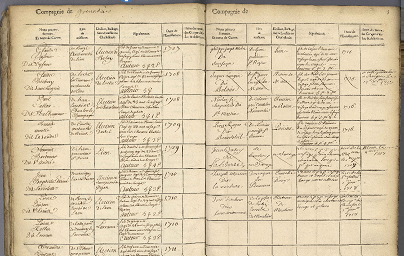

For over four years, Ivan Leplumey - professor at INSA Rennes and member of the Intuidoc/Shadoc research team - has been supervising a student project aimed at creating digital reviews of Ancien Régime registers, based on thousands of images and annotations from these registers.
This project is part of a collaborative approach with the Mémoire des Hommes website, which provides thousands of images of military registers describing French regiments, including those from the Ancien Régime (late 17th to 18th centuries). Lecturer resarcher lvan Leplumey and his students are importing these images and, with the help of some forty departmental archives and associations*, the associated annotations are being produced by experienced volunteer annotators.
While the pedagogical aim of this project is to help students develop their IT skills in the context of a real application, all the partners in this work also benefit from the dedicated results.
Thousands of images of military registers and associated annotations transformed into evolving digital journals
Thousands of images of military registers and annotations are re-imported, checked and recognised, leading to the creation of evolving digital journals in pdf format, with content specifically tailored to the journal's target partner.
To date, more than 40 journals have been created, totalling 11,600 pages, divided into three types of journal.
- Geographic magazines, aimed at archives and associations.
These journals contain soldiers from the geographical area corresponding to the target partner. For example, the journal for the Dordogne archives lists the soldiers of the Périgord region.
Examples of magazines : Les soldats Picards - Les soldats Picto-Charentais - Les soldats Flamands et Picards - Regiment-oriented journals, intended for Mémoire des Hommes.
These reviews contain one or more registers annotated by one or more annotators. For example, the journal on the Limousin regiment contains 850 pages including 4 registers, annotated by a single annotator.
To consult the mémoire des Hommes website with the journals available: Site Mémoire des Hommes - The last type of journal is the annotator journal: regiment-oriented but with a single annotator. The aim is to give the annotator a global view of his work and additional statistical results.
These digital magazines are scalable and clickable
The internal organisation of the journals provides a wealth of information, including
- a presentation by regiment and register in each journal
- a more or less detailed history
- a series of associated statistics
- paragraphs describing the soldiers, including their place of birth, parents, occupation and date of enlistment
- indexes of places or surnames to speed up searches of these documents.
The digital journals are open-ended, because each time a new register is annotated, the journals with a geographical scope are updated. They are also clickable, with a link for each soldier leading directly to the image of that soldier on the Mémoire des Hommes website. This link allows the reader to return to the source information, the original image, to check its veracity.
How did the students go about collecting and transcribing all this information?
For the students, the first step was to realise how complex it was to decipher the documents of the time. Complexity linked in particular to the difficulty of identifying a place or a surname due to spelling that was sometimes approximate or difficult to read. Based on deap learning and artificial intelligence techniques, image recognition involves analysing, recognising and interpreting the document in order to transcribe the correct spelling. To help consolidate the spelling of surnames, the students used the Geneanet website, a partner of Mémoire des Hommes, which lists 7 billion people.
As part of the project, around ten software packages have been written. The first creates an Excel file for annotators to enter their data as they read. Another reads all the permalinks to images in a register on the Mémoire des Hommes website. A third will download a collection of images for disconnected annotators. The next will help identify a commune in France by telling the software the region and part of the commune's name. One will take care of the statistical calculations and another will create the soldier paragraphs... Finally, the LaTeX language will combine all the results to create a clickable pdf review.
And the work continues to progress over the years, thanks to the work of INSA students under the supervision of Ivan Leplumey and with the collaboration of the various partners.
contact : ivan [*] leplumey irisa [*] fr
irisa [*] fr
*The partners involved in this project, over 40 in all:
Mémoire des Hommes portail culturel du Ministère des Armées, Geneanet, l'association Ancestramil,
les Archives d'Alsace, les Archives d'Eure-et-Loir, les Archives d'Indre, les Archives d'Indre-et-Loire, les Archives de Charente, les Archives de Dordogne, les Archives de l’Aisne, les Archives de l’Aube, les Archives de l’Eure, les Archives de l’Oise, les Archives de la Haute-Marne, les Archives de la Haute-Saône, les Archives de la Marne, les Archives de la Meuse, les Archives de la Nièvre, les Archives de la Seine-Maritime, les Archives de la Somme, les Archives de Loir-et-Cher, les Archives de Maine-et-Loire, les Archives de Meurthe-et-Moselle, les Archives de Moselle, les Archives de Paris, les Archives de Seine-et-Marne, les Archives des Ardennes, les Archives des Vosges, les Archives des Yvelines, les Archives du Calvados, les Archives du Cher, les Archives du Doubs, les Archives du Jura, les Archives du Loiret, les Archives du Nord, les Archives du Pas-de-Calais, les Archives du Puy-de-Dôme, les Archives du Rhône ,
l'Association des Chercheurs et Généalogistes des Cévennes (30, 48), le Centre Généalogique des Côtes d'Armor (22), le Cercle Généalogique de la Manche (50), le Cercle Généalogique de la Charente (16), le Cercle Généalogique en Uzège et Gard (30), le Cercle Généalogique Maine et Perche (53, 61, 72), la Société Généalogique du Lyonnais et du Beaujolais (69)
